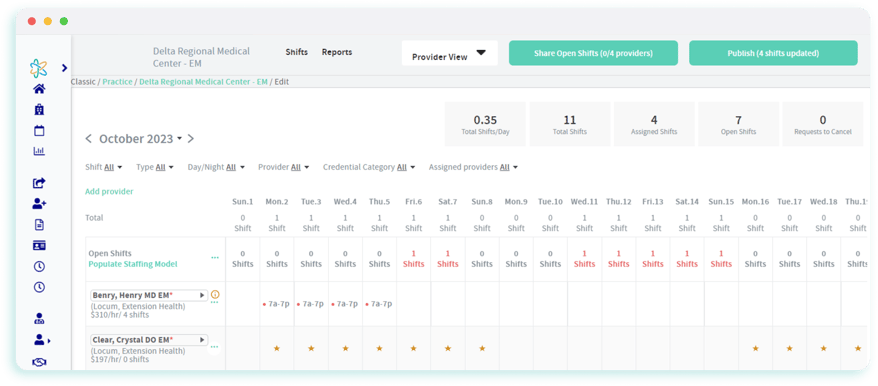Juggling shifts is an art in healthcare. If you’re in charge of shift scheduling in your organization, odds are sometimes you feel like you’re constantly working on masterfully coordinating a symphony of doctors, nurses, and staff across facilities. But, what happens when the tempo speeds up? The music falls out of rhythm. Providers aren't aligned with patient needs. Care suffers.
This is the "shift scheduling" challenge. As demand escalates, healthcare scheduling capacity bottlenecks. Requests pile up. Providers wait in the wings. Patients experience delays and gaps in care. It's time to rewrite the sheet music to get back to that blissful symphony isn’t it?
The ability to boost shift scheduling capacity is key to high-functioning healthcare operations. Efficient alignment of the right providers to facility needs ensures seamless coverage. Patients feel cared for. Doctors feel supported. Organizations hit their stride.
Unfortunately, capacity limits plague even the best schedulers. Heavy reliance on manual processes - you know the type - endless calls, texts, and emails, these drag productivity down. Information silos make shift coordination tedious, if not impossible.
The good news? With the right strategies and tools, your shift scheduling productivity can skyrocket. If this sounds good, keep reading.
What Is Physician Shift Scheduling?
Physician shift scheduling refers to the process of creating work schedules for doctors and other medical professionals. The main goals of physician shift scheduling are:
- Ensuring adequate staffing levels to provide high quality patient care at all times. This includes having enough providers to handle patient volume and acuity during busy shifts as well as providing appropriate overlapping coverage for handoffs between shifts.
- Meeting legal and regulatory requirements for issues like meal breaks, rest periods, on-call duties, and maximum shift lengths.
- Balancing provider fatigue, burnout risk, and work-life balance by distributing shifts equitably and minimizing excessive back-to-back shifts.
- Accommodating provider preferences and their availability as much as feasible.
- Ensuring contracted levels are met. Schedulers spend so much time recruiting, interviewing and privileging providers, it’s important to ensure you are getting your minimum shift limits or setting maximum limits for patient safety.
- Maximizing operational efficiency and minimizing labor costs by aligning staffing to expected patient demand.
The schedule is typically set weeks or months in advance using scheduling software that facilitates creating, managing, and communicating the schedule.
Factors considered include things like
- Past patient volume data
- Seasonality
- Holidays
- Provider requests, and more.
The schedule may be adjusted as needed to account for real-time circumstances like call-outs. Ongoing schedule management and communication is crucial for an effective physician scheduling process.
5 Tips to Boost Shift Scheduling Capacity

Cranking up scheduling velocity requires rethinking old models. Let’s overhaul inefficient practices to boost productivity. Here are five fail-proof tips to expand capacity:
Streamline Communication Channels
Consolidate availability sharing and shift requests into unified digital platforms.
Keeping up with phone calls, scattered emails, texts, and paper calendars bogs down even superstar schedulers. End the madness! Consolidating availability sharing and staff requests is key for efficient coordination.
Automate notifications and approval workflows rather than manual reminders.
Unify everything in a single digital platform. Digitize outdated paper trail processes to automatically track approvals, notifications, and confirmations. Configure customizable automated workflows to replace manual reminders via email or phone tag. Get real-time visibility into shift status rather than playing “phone tag.”
Avoid scheduling via decentralized calls, texts and emails.
Funnel all communications through connected digital systems. Everyone stays linked on the same page.
Configure shift warnings for capacity risks
Set automated flags when shifts push utilization limits like consecutive hours regulations or weekend frequency policies. Get alerts on overburdened resources before care quality suffers.
Build robust cross-facility staff pools
Tap into your greater workforce network potential. Moonlighters, part-time staff, locums and cross-trained internal float pools offer immense flexibility. Unify visibility into this broader roster for smarter deployment when gaps arise.
Centralize Shift Availability
Trying to schedule staff when availability data sits in siloed spreadsheets and paper grids is wildly inefficient. How can you know the right providers to slot for a shift when visibility is fractured? Chaos ensues.
Aggregate provider availability across facilities into a single schedule.
Everything in one place makes shift coordination much smoother.
Use smart algorithms to match open shifts to qualified, available providers.
Sophisticated shift matching algorithms can then work behind the scenes to automatically recommend the optimal available providers for open roles based on credentials, facility access, past performance—whatever unique criteria you configure. Making perfect matches happen automatically, with no more spreadsheet headaches.
Give providers mobile access to claim shifts in real-time.
When you give providers mobile shift claiming capabilities, you enable real-time flexibility. Empower your team to lock in shifts whenever they have availability, no matter where they are. Accommodate last minute schedule changes with no disruption to operations or patient care.
Centralized availability data, automated shift matching, and mobile self-scheduling form a dream-team to demolish scheduling headaches. Are you ready to win back hours of coordination chaos each week?
Optimize Scheduling Workflows
Build templates for recurring shift types to automate shift scheduling.
Scheduling is filled with repeatable patterns. Take advantage by optimizing workflows around common shift templates. Build templates within your scheduling system for frequently recurring shift types associated with specific roles or departments. Configure all the complex requirements just once. Then auto-fill future shifts based on demand volume and provider qualifications with a single click. Hours of manual configuring transformed into seamless rapid fire scheduling!
Configure rules for shift assignments, notifications, and substitutions.
Don’t stop with templates! Create business rules tailored for assignment notifications, shift confirmation protocols, substitution policies and more. Customize automated triggers to keep operations running like clockwork. Reduce the barrage of questions schedulers field from managers and providers. Empower your team to understand expectations with consistent automated touchpoints.
Analyze scheduling data to continuously refine efficiency.
Leverage your analytics to take your optimization up another notch. Gain visibility by dissecting volume trends, identifying peak request periods, compiling constraint alerts and assessing responsiveness. Refine your templates, rules and notifications informed by data-driven insights into the unique rhythm of your operations. Evolve your scheduling ecosystem to achieve unprecedented alignment of provider qualifications with patient demand.
Enable Self-Scheduling
Allow providers to directly claim or swap shifts through self-service portals.
Who understands provider availability best? The providers themselves, of course! Self-scheduling through intuitive portals gives providers direct control to claim or swap shifts in line with personal schedules. No more waiting for the middleman. Providers assume accountability over their hours while reducing administrative burden. It’s a win-win for team empowerment and operational efficiency.
Give managers oversight while reducing coordinative burden.
Configurable permissions let managers retain necessary oversight for policy adherence without getting mired in constant coordination. Find the right balance between provider flexibility and governance for a smooth-running environment. Limit serial shift swapping while still encouraging coverage flexibility. Self-scheduling promotes accountability but smart guardrails avoid overcorrection issues.
Foster provider empowerment and accountability through self-management.
Don’t overlook the culture bonus! Giving physicians more autonomy over scheduling decisions directly improves job satisfaction by respecting their time. providers feel heard while still working within established team standards. That’s a boost for both morale and your bottom line through enhanced retention. Talk about self-scheduling advancing your quadruple aim goals!
Share Open Shifts Broadly
Having unfilled shifts cripples care continuity. Yet limiting visibility to a small fixed provider pool restricts scheduling agility. Broaden your reach for shift coverage without sacrificing governance or strategic partner preferences.
Expand your pool of potential providers by broadcasting unfilled shifts widely.
Do this across internal teams and trusted external partners via automated notifications. Widen the talent pool to fill gaps. Include contingency and on-call staff groups.
Configure permissions so agencies only view details relevant for staffing decisions. Customize external shift sharing rules based on partner type, specialization, performance history etc. Target notifications to the ideal providers for seamless care.
Track confirmations and credentials to ensure quality coverage.
Set automation to track provider confirmations and credentials before slotting assignments. Ensure patient safety with rigorous yet efficient vetting protocols. Automate reference checks if needed. Integrate with privileging systems to verify qualifications. Curate visibility precisely while upholding consistency safeguards.
Get the flexibility of a broad fill-in provider ecosystem paired with governance to verify exceptional performance. Instantly tap specialized support with targeted shift visibility. Automate quality checks so great talent easily plugs gaps. Let your workforce stretch to its full coverage capacity with simplified coordination tools. Patients win. Providers win. Your operations win.
Now that’s the kind of intelligent shift sharing any scheduler would appreciate!
Rev Up Your Shift Scheduling Results With Kimedics

One medical group that tried Kimedics software saw a 3X scheduling surge. Let’s take a peek behind the curtain at what happened when they implemented our shift scheduling software.
The Challenge
- 200+ physicians across multiple specialties
- Mix of full-time, 1099, and locum providers
- Scheduler limited to 300 shifts/month.
The Kimedics Solution
- Intuitive shift board to share availability in real-time
- Automated shift notifications and confirmations (no more back and forth correspondence!)
- Mobile app for simple shift claims by providers.
The Impact
- Scheduling capacity increased to 900 shifts/month
- 4 new practices added with no additional support staff needed
- Streamlined workload despite exponential growth
The key? Consolidated visibility, automated workflows, and mobile self-scheduling. Kimedics amplified this group’s throughput while ensuring seamless care coverage.
When scheduling gets stuck, patient care derails, and provider burnout risk increases. Moving from manual to modern systems keeps your healthcare engine humming. Your skilled providers, dedicated administrators, and vulnerable patients deserve optimized coordination.
Step on the efficiency accelerator with optimized workflows, analytics, and tools purpose-built for healthcare scheduling’s unique needs. Take your capacity to the next level with Kimedics.
With us on your side, you can accelerate your scheduling to master provider coordination at scale. Contact us to learn more and schedule a demo today!


